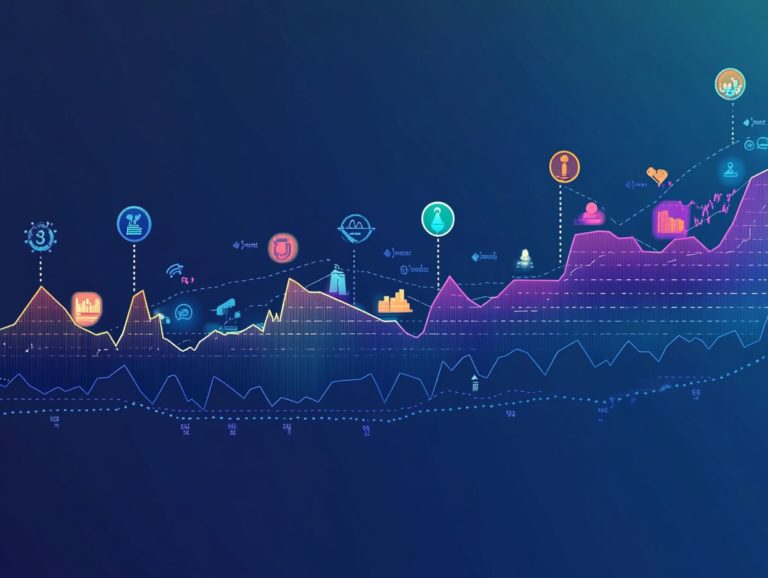The Correlation Between Market Trends and Economic Data
In today s ever-evolving financial landscape, grasping market trends and economic data is essential for making informed decisions.
This article delves into the complex relationship between these two elements, uncovering how economic indicators can influence market movements and, intriguingly, how the markets can affect economic conditions in return.
You ll explore the myriad factors shaping trends from political shifts to technological advancements and gain practical tools for interpreting the data.
By the end, you ll be equipped with a clearer understanding of how to leverage this information for strategic decision-making in your investments and business strategies.
Contents
- Key Takeaways:
- Why Market Trends Matter
- The Relationship Between Market Trends and Economic Data
- Factors That Influence Market Trends and Economic Data
- Interpreting Market Trends and Economic Data
- Using Market Trends and Economic Data for Decision Making
- Frequently Asked Questions
- What is the correlation between market trends and economic data?
- How are market trends affected by economic data?
- Can market trends be used to predict economic data?
- How do market trends and economic data affect investment decisions?
- What are some examples of economic data that can impact market trends?
- How can one use the correlation between market trends and economic data to make informed decisions?
Key Takeaways:

Here are the key points to remember:
Why Market Trends Matter
Understanding market trends and economic data is vital for you as an economist, financial institution, or investor. It offers invaluable insights into economic indicators that reveal the overall health and performance of a market.
By analyzing big economic numbers such as GDP (Gross Domestic Product), unemployment rates, and consumer confidence you can make informed decisions that shape your investment strategies and enable you to respond adeptly to economic shifts.
This knowledge helps you monitor market fluctuations in real time and enhances your ability to predict future economic conditions effectively.
Defining Market Trends and Economic Data
Market trends indicate the general direction in which your market is moving, influenced by various economic data and indicators. Economic data consists of statistics that reflect the current state of the economy.
To truly grasp market trends, you ll want to analyze different types of economic indicators, which can be categorized into leading, lagging, and coincident indicators. Leading indicators, such as new housing starts or consumer confidence surveys, offer a glimpse into future economic activity. Conversely, lagging indicators like employment rates or GDP growth confirm what has already occurred, revealing past trends and cycles.
Indicators that move with the economy, like personal income or retail sales figures, shift in harmony with the market. By meticulously examining these metrics, you ll unlock valuable insights that empower your decisions in areas like investments, policy-making, or business strategies.
The Relationship Between Market Trends and Economic Data
The relationship between market trends and economic data is remarkably intricate. Understanding market trends through historical data can shed light on how fluctuations in economic indicators significantly impact market performance and investor sentiment, ultimately shaping your investment strategies and economic forecasts.
Understanding this interplay can position you to make more informed and strategic decisions in your financial endeavors.
How Economic Data Impacts Market Trends
Economic data is crucial in shaping market trends, offering you vital insights into consumer spending, inflation rates, and the overall economic landscape that financial institutions and savvy investors keep a close eye on.
Key indicators like the Purchasing Managers Index (PMI) and the Durable Goods Report are essential for gauging economic health. When the PMI rises, it usually signals expanding manufacturing activity, sparking optimism among investors. A weak Durable Goods Report can suggest waning consumer demand, raising red flags.
Additionally, the Federal Reserve’s monetary policies like adjustments to interest rates can significantly impact market perceptions. When the Fed hints at a potential rate hike, markets often react swiftly, adjusting stock prices in anticipation of tighter borrowing conditions.
These intricate relationships between various data points and market sentiment underscore the importance for you to stay informed and adaptable.
How Market Trends Affect Economic Data

Market trends can profoundly influence economic data by shifting consumer behavior, investment strategies, and financial market conditions. This leads to noticeable fluctuations in the statistical measurements of economic performance.
As sectors adapt to evolving consumer preferences and investor sentiment, it s crucial to stay alert and capture these dynamics to accurately reflect the economy’s true state. For instance, during times of heightened market volatility, you may notice that initial readings of indicators like GDP growth or unemployment rates undergo significant revisions. A sudden drop in stock prices could trigger a decline in consumer spending, prompting you to reassess forecasts.
Similarly, a spike in commodity prices might indicate inflationary pressures, pushing you to adjust your analysis methods. Ultimately, recognizing the interconnectedness of market trends and economic indicators highlights the need for adaptive methodologies in data collection and analysis.
Factors That Influence Market Trends and Economic Data
Several key factors influence market trends and economic data, ranging from political and social dynamics to technological advancements that can reshape industries and alter consumer behavior.
Political and Social Factors
Political and social factors, such as trade agreements and economic policies, significantly influence market trends and shape the economic landscape in ways you might not always realize.
For example, government regulations can impose restrictions that either promote or stifle certain industries, leading to immediate shifts in consumer behavior and confidence. Trade agreements, on the other hand, often open new market opportunities by reducing tariffs and fostering international collaborations. This can spark increased competition and innovation.
Social movements can shape public opinion around issues like environmental sustainability or ethical consumption, creating a surge in demand for greener products. These dynamic interactions between policy, commerce, and societal values highlight the complexity of economic activity and emphasize the necessity to adapt to ever-evolving conditions.
Technological Advancements
Technological advancements have completely transformed how data is collected and analyzed, enhancing both the accuracy and speed of data-driven decision-making in financial markets.
This evolution allows access to vast amounts of real-time information, significantly impacting investment strategies. With the integration of tools like data visualization and predictive analytics, which uses data and algorithms to predict future outcomes, it’s easier to discern trends and make informed choices. These innovations enable tracking market fluctuations instantaneously, often predicting outcomes with remarkable precision.
As a result, harnessing these technologies not only helps navigate the complexities of the market but also cultivates a culture of agility and responsiveness in investment approaches.
Interpreting Market Trends and Economic Data
Interpreting market trends and economic data demands a thorough and nuanced approach. Employing a variety of tools and methodologies ensures accurate data analysis and provides insightful perspectives into the financial markets.
This multifaceted strategy allows you to navigate complexities with confidence and precision, empowering you to make informed decisions.
Tools and Techniques for Analysis

Various tools and techniques are crucial for analyzing economic data and understanding market trends. These include statistical metrics and analytical software.
Key methods involve econometric models, which analyze economic data relationships, and data visualization software, which simplifies complex information into digestible formats. By leveraging these analytical tools, you can unlock valuable insights that clarify market dynamics and empower stakeholders to make informed decisions.
The integration of predictive analytics enhances your ability to anticipate future developments, guiding your investment strategies and improving your responsiveness to market fluctuations.
Using Market Trends and Economic Data for Decision Making
Leveraging market trends and economic data is essential for informed decision-making in your investment strategies and business choices across various sectors.
By tapping into these insights, you can navigate complexities and seize opportunities with confidence.
Strategies for Utilizing Information
Effective strategies for leveraging market trends and economic data can significantly enhance your success in financial markets and contribute to overall economic health.
By analyzing these trends, you can make informed decisions that optimize your portfolio while minimizing risk. For example, monitoring shifts in consumer preferences can prompt timely adjustments in your product offerings or investment strategies.
Look to businesses like Starbucks, which skillfully harness data analytics to refine their operational strategies and identify lucrative markets. Such actionable insights not only guide your investments but also elevate your business planning, ensuring agility in an evolving economic landscape.
Frequently Asked Questions
What is the correlation between market trends and economic data?
The correlation between market trends and economic data refers to the relationship between stock market performance and the economy’s current state. Analysts often rely on resources like understanding market indicators and their trends to predict future market movements.
How are market trends affected by economic data?

Market trends are greatly influenced by economic data, which provides insights into current and future economic conditions. Factors like interest rates, inflation, and GDP growth significantly impact market trends.
Can market trends be used to predict economic data?
While market trends offer valuable information about the economy’s current state, they are not always reliable indicators of future economic data. Economic data is influenced by various unpredictable factors.
How do market trends and economic data affect investment decisions?
Market trends and economic data are crucial for investors when making decisions. They provide insights into potential risks and opportunities, helping investors make informed choices.
What are some examples of economic data that can impact market trends?
- Unemployment rates
- Consumer spending
- Consumer confidence
These indicators offer insight into the economy’s overall health and can affect stock prices and market movements.
How can one use the correlation between market trends and economic data to make informed decisions?
You can use the correlation between market trends and economic data to predict future market movements, identify risks and opportunities, and make informed investment decisions. Understanding the relationship between market trends and risk is essential for a comprehensive understanding of market dynamics.
Take Action: Start applying these insights and tools today to enhance your decision-making process!






